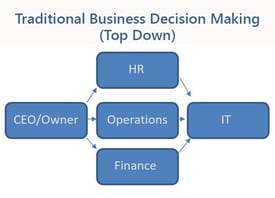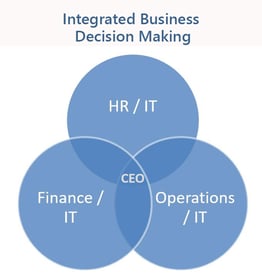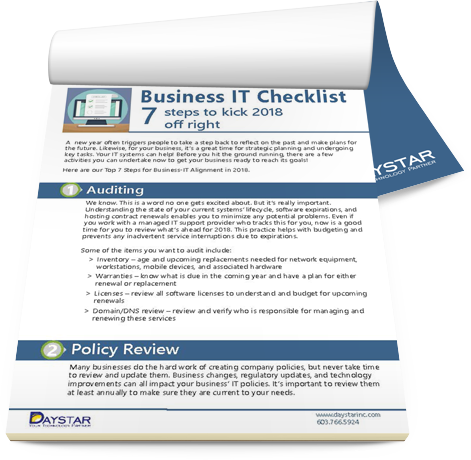 When people think of transformative technology, they often picture big, enterprise companies with massive IT spending budgets, and a team of in-house engineers implementing super cutting-edge technology. But it’s more than that. Digital transformation is not a big business phenomenon; in many ways, it’s meant for small and midsize businesses. Combining the application of digital transformation with a business technology alignment strategy is a true game changer for smaller organizations. It unleashes a competitive advantage that enables them to do things previously thought unattainable.
When people think of transformative technology, they often picture big, enterprise companies with massive IT spending budgets, and a team of in-house engineers implementing super cutting-edge technology. But it’s more than that. Digital transformation is not a big business phenomenon; in many ways, it’s meant for small and midsize businesses. Combining the application of digital transformation with a business technology alignment strategy is a true game changer for smaller organizations. It unleashes a competitive advantage that enables them to do things previously thought unattainable.
What is digital transformation?
At its most basic level, digital transformation is the use of technology processes and tools to make a strategic change. It’s less about the technology and more about how a business is deliberately using it to create an improved outcome. It can encompass new, cutting-edge, and disruptive technologies like Internet of Things or Big Data. Or it could leverage existing tools in new ways, like automation or increased cloud capabilities.
Often, the most impactful transformations involve using existing infrastructure in new ways to provide improved value. This is what makes digital transformation so accessible for small businesses. You don’t necessarily need the deep pockets of larger businesses to take advantage of it. There are ways to leverage transformative IT with tools that you’re already using.
The most critical part of digital transformation lies in the word transformation. Its application should result in some sort of change that produces an outcome. This is entirely customizable and should align to the needs of your business and what you want to accomplish. Are you trying to change how your employees communicate internally? Or do you need to simplify an operational process? Perhaps your goal is to transform your customer’s experience with your company online? Effective digital transformation begins with a goal in mind and then leverages technology to help you accomplish it.
It’s a strategic way of looking at technology applications and one that often requires your team to approach IT in a new way.
Digital Transformation Mindset: Infrastructure vs. Outcomes
 Traditionally, businesses approached technology initiatives with an Infrastructure mindset. The focus was on the physical component of IT – workstations, servers, switches, application integration, etc. IT managers were tasked with supporting the infrastructure and keeping systems up and running. New technology initiatives were commissioned by the business side and directed onto IT. The IT team operated in a silo, putting out fires and completing projects.
Traditionally, businesses approached technology initiatives with an Infrastructure mindset. The focus was on the physical component of IT – workstations, servers, switches, application integration, etc. IT managers were tasked with supporting the infrastructure and keeping systems up and running. New technology initiatives were commissioned by the business side and directed onto IT. The IT team operated in a silo, putting out fires and completing projects.
But that was yesterday. As business technology has matured and systems have become more sophisticated and reliable, those traditional needs are no longer the priority. What’s more, technology now permeates virtually every aspect of the business. Today, successful businesses are shifting to an  Outcome mindset. To stay competitive, they prioritize technology-enabled outcomes that transform their business to a future success.
Outcome mindset. To stay competitive, they prioritize technology-enabled outcomes that transform their business to a future success.
In an outcome-based mindset, technology is fully integrated with business process, from HR to Finance to Operations. New initiatives are directed by cross-functional teams in a collaborative approach. As such, they become more strategic. Rather than focusing on how many computers are needed or changes to the WiFi configuration, businesses are exploring how IT can support employee onboarding, or what technology can do to make the customers’ online experience more personable. The focus shifts from components to results.
Those outcomes vary depending on what your business’ goals are. Still, there are some key main drivers that are often the catalyst for digital transformation.
How Digital Transformation Helps Small Businesses
There are four main areas that drive digital transformation strategy:
-
Customer Experience
This is arguably the most common motivator. Enhancing the customer experience and earning loyalty and returning business is key to business growth. Outcomes are often centered around:
- Increasing customer engagement
- Enhancing how clients interact with your business
- Improving customer retention
-
Employee Engagement
Although customer focus is most common, I would argue that employee engagement is probably the most important. It’s no secret that finding and retaining talented staff is a major challenge. Does your technology attract or frustrate your team? Some common outcomes in employee engagement center around:
- Increasing effective employee collaboration
- Removing obstacles
- Improving employee retention
-
Operational Processes
This is where technology initiatives have always shined – in its ability to help us work smarter and faster. And that’s as critical in today’s competitive market as it always has been. New operational process outcomes focus on:
- Increasing efficiency with process digitization and workflow automation
- Improving productivity with worker enablement and collaboration tools
- Making informed decisions with business intelligence and analytics
-
Business Model
Staying relevant and competitive in today’s changing business climate is critical. Technology helps businesses identify new markets or initiatives and develop future growth strategies. Business model outcomes help:
- Uncover new service/product offerings
- Redefine new processes complimenting traditional models with digital technologies
Over time, businesses will undertake new initiatives that fall under a combination, if not all, of these four main drivers. What’s important is to focus on outcomes that drive growth for your business. By properly aligning your business goals with your IT initiatives, you can prioritize the outcomes that will provide the most impact.
Although it may seem like the hot new buzzword, digital transformation is not a new concept. Many businesses are already doing it, without realizing it’s a “thing”. The difference with transformative IT now is that businesses actively see it and recognize its potential impact. That awareness leads to the development of strategic initiatives that really unlock the power of digital transformation.














